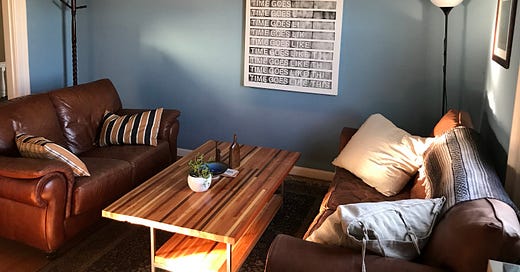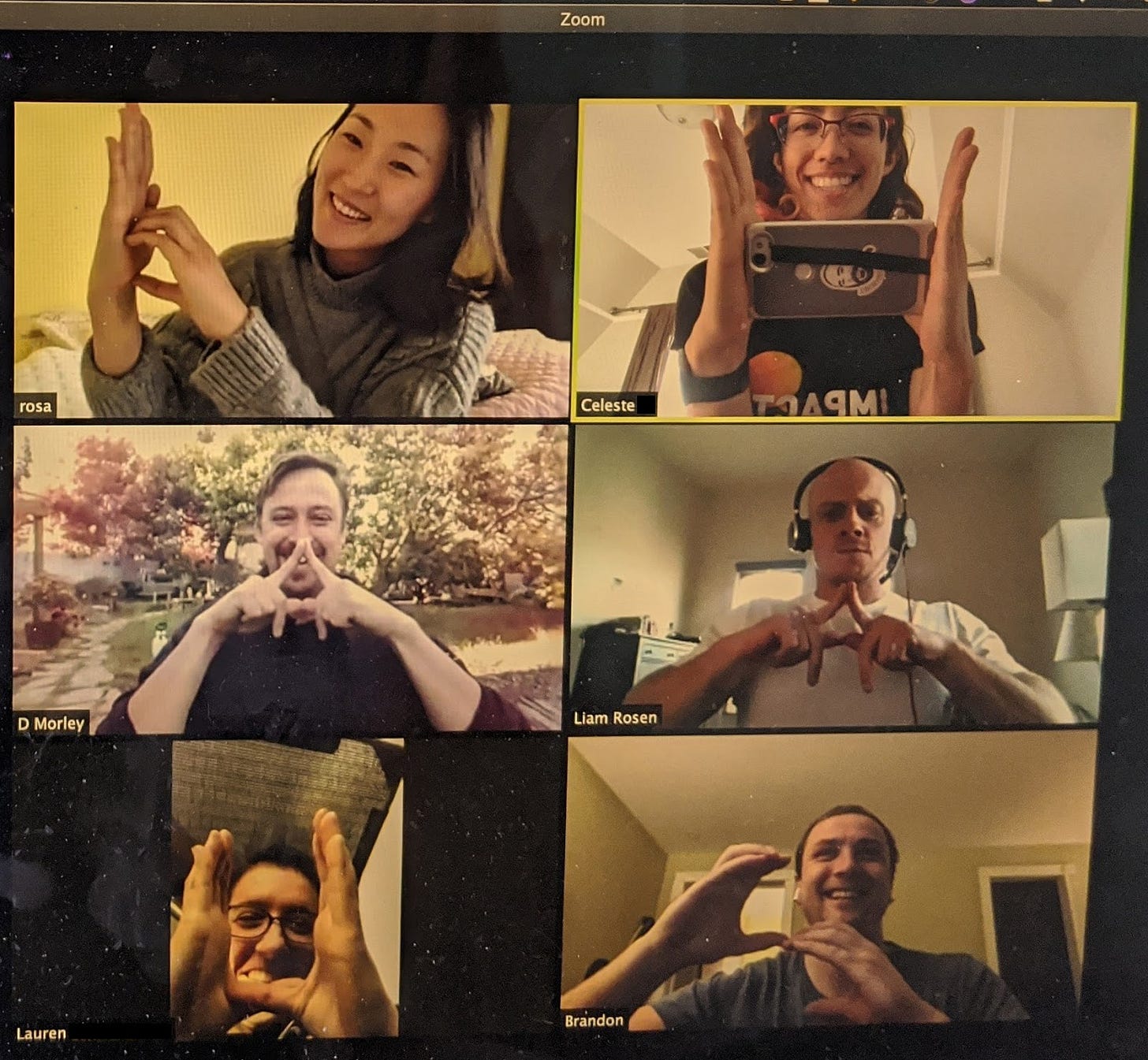Editor’s note: This is a reader-submitted case study from Liam Rosen, who started Bauhaus, a ‘semi-intentional’ community in Oakland, California. This is part of an ongoing series of deep dives on coliving spaces. To see others, visit the Supernuclear directory.
If you want to contribute a case study of your community, let us know at hi@gosupernuclear.com
Welcome to Bauhaus
Date Founded: 2015
Location: West Oakland, California
Rented or owned: Rented
Physical space: 4.5 bedroom upper floor of a Victorian duplex
Governance: Consensus-seeking democracy
Origins
Until I moved to Oakland in 2014, I had never considered coliving. During my several week housing search, I was entranced by the sweet coliving spaces that sporadically appeared on craigslist advertising open spots. I applied to as many as I could find with a detailed description of my personality and interests, hoping with naiveté that my profile would be accepted to join a community.
The naiveté soon gave way to the realization that being chosen for one of these spaces was more competitive than I had thought. The first reason was the sheer amount of people interested; the few callbacks I did get, I was invited to “meet and greets”, de facto college Greek house-like rush events where dozens of people came to a potluck dinner under the auspices of the current residents vetting an eventual new housemate. It was about as awkward as you can imagine.
The second reason, as I soon came to find out, is that many intentional coliving spaces in Berkeley and Oakland were either ideology-first (you should believe a certain thing), or identity-first (you should belong to a certain group). Listings came with either an explicit or unexplicit message of “We’re looking for people that are like us.” While I understood the appeal of living with people that shared the same background and identity, I wondered whether it was healthy to create a potential echo chamber.
Alas, for the first year, I was forced to settle for the opposite extreme — unintentional shared housing with no sense of community, where people mostly stayed in their rooms. I hated it. The final straw came when I heard my master tenant say: “I don’t care who lives here, as long as they pay rent on time.”
Frustrated, I wondered if there were others like me: people who cared deeply about community and the benefits of shared living, but also wanted to live in a space unbounded by a particular ideology, and perhaps even live in a mixed community where people might learn from different backgrounds and viewpoints. That night, in a fit of inspiration, I posted an ad on craigslist entitled: “Let's start a semi-intentional living community!”. It outlined my vision for a community unrestricted by belief or background, where the only values needed for inclusion were commitment to honesty, communication, and transparency.
The response was immense. I immediately had more people interested than I knew what to do with! People really seemed to resonate with the idea. Two of the people that wrote in ended up being friends of friends and actually identified me from the ad. They had their own stories of feeling like they weren’t radical enough for shared living, as well. Two quick calls later and we had our group of three, eager to find the place for us.
The Search
We remained in our current places of residence during the search for a house, so online communication was vital.
Luckily, we found an amazing collaborative web app for sharing and commenting on rental listings called Lasso. Lasso has since gone through several redesigns and is no longer as useful for rentals, but the 2015 interface was awesome: with one click, it could scrape a rental listing, add it to a “corral”, where everyone invited could comment, view, and rate the various listings.
With Lasso, any one of us could trawl through listings and quickly add them for the approval of others. If any listing got votes from all of us, we would arrange for one of us to do a viewing, in which we would do a virtual walkthrough with our phones. We then uploaded the video to Dropbox and pasted the link back to Lasso. In this way, everyone could feel like they got to tour the place in some way, even if our schedules didn’t align.
After viewing over 15 places, we found our home: the top floor of a Victorian duplex in West Oakland. Listed at four bedrooms, it was already a steal at $2600, and imagine my surprise when I flung open one of the doors to find an unlisted smaller bedroom, perfectly capable of housing another person, if they were OK with a smaller space. We were overjoyed: at a time when the average monthly rent of a four-bedroom in Oakland was ~$3500, we had found a potential five bedroom for much less.
The Values
After signing the lease and moving in, we had an initial meeting to formalize our values. Though the three of us had roughly hashed them out through in-person conversations during the housing search process, we wanted to put pen to paper and create something that we could turn into a craigslist ad to find our one or two remaining housemates.
We started with what I had written in my initial ad: “semi-intentional living”. To us, this meant coliving without the intense commitment of house dues, forced projects, service, or events, or sharing food. It also meant leaving ideologies behind and being open to all types of people, as long as they shared the basic values of respectful cohabitation. We also wanted to be as inclusive as possible, no matter where potential housemates fell on the weird spectrum.
We then came up with four formal values:
Open and honest communication - we wanted decisions inside the house to be transparent to everyone, and all housemates to feel comfortable bringing up issues with each other one on one.
Create a warm and inviting space - we had moved into an empty, recently-remodeled space that lacked charm. We wanted residents to commit to improving the house and turning it into a place where we would feel comfortable bringing guests.
Having dialogue/interaction with housemates - we were wary that our catchphrase of “semi-intentional” living could quickly fall back to the “everyone stays in their rooms” type of shared housing that we had all experienced. This value existed to remind ourselves that, after all, the reason for coliving was what we could learn and share with each other.
Respect each other and the space - we felt that this was a good catch-all for all norms that didn’t fall under the above three.
We ended the meeting by choosing a name: the Bauhaus, a nod to fact that two out of the three of us spoke German (none of our architecture or design choices ended up being inspired by the Bauhaus movement, it just stuck out to us as a cool name). There was some discussion about whether to name the house or not. In the end, I’m very glad we did. A name builds meaning and helps to give residents ownership in something greater than themselves.
Inner Workings
Finances
Splitwise has been a godsend for us. We have a recurring task to auto-add rent and fixed utilities, and everything else is added manually.
We have a house norm that people can buy and add anything under $25 that they believe everyone in the house would use. Anything above that requires a quick confirmation via group text.
Chores
Everyone hates chore wheels, but assigning people to chores permanently also feels inflexible, and can create the feeling that others are being given license to slack in a particular area, knowing that someone else is responsible.
We found a good middle ground in assigning a person as a “guarantor” for each chore. For example, the kitchen guarantor is, at the end of the day, responsible for keeping the kitchen clean — but it is the responsibility of everyone to chip in. If the guarantor feels that this was not being done adequately, he or she gets the kitchen back to an acceptable level of cleanliness, as well as follows up with others to make sure it doesn’t happen again.
Meetings
A typical Bauhaus meeting looks something like this: we have a Google Doc where the person running the meeting creates a rough outline to be shared to everyone in advance. Everyone who has something to bring up can then add it directly to the doc. During the meeting, as items get discussed, the scribe will then flesh them out, and if needed, assign action items to relevant people.
Other things we have learned over the years:
Reiterate the house values at the start of any meeting where someone new has joined the house. This not only introduces them to the new housemate, it also allows for further insight, and even potential revision of existing values.
Talk about chores and other potentially contentious issues last. This allows everyone time to break the ice and re-establish rapport (yes, rapport does need to be re-established, even with people who have lived together for years!).
We’ve had success with a lighthearted “gripes” section at the end: a codified section where anyone can bring up something that is bothering them.
Right after a house meeting is a great time to schedule a small project, like a fridge clean to throw away expired items. People are usually pumped up about future projects and want to get the excitement out right away.
Finding and Vetting New Housemates
We’ve done a lot of experimenting around how to best find new housemates and have settled on what we feel is a pretty good system.
It all starts with a detailed craigslist ad, outlining our house culture and providing paragraph descriptions of each of the housemates. As most craigslist listings tend to provide next to no color, we already feel that this helps us stick out.
The email on the craigslist account goes to a shared inbox which everyone in the house has access to. Once we have a sufficient number of candidates, the current housemates go through and vote using Gmail’s label feature on who they’d like to invite for an interview.
Once there’s a rough consensus, we send out a calendly link to each candidate to schedule a 25-minute slot. This prevents too much email back and forth and makes sure candidates don’t schedule over each other.
On the visits, one person gives a tour of the house, and at the end, we all sit in the living room together and do the get-to-know you thing. We always spend most of this time asking the candidate what questions they have about us — the type of questions someone asks are often most instructive as to whether they’d be a good fit or not (the person who asked if we would mind if they brought their big screen TV into the living room was not a good fit).
At the end of the visit, we always make sure the candidate knows that vetting is a two way process. We know that each candidate is also looking at multiple houses, so even if they’re interested right away, we ask them to sleep on the decision and send us an email the next day confirming their interest.
Only after we’ve done all the visits do we get together in person as a house and compare notes. Usually, there’s an immediate consensus towards one or two people — this is the benefit of having strong house values and housemates that are aligned.
InsideOut Haus - our group Halloween costume in 2015
What We Learned
We’ve learned several useful coliving tips over the past six years:
All You Need Are Values
When we started the Bauhaus, we were all new to coliving. All we at the beginning were a small set of values, but it turns out that’s all we needed. After six years, the house has gone through so many different iterations that the core values are practically the only things that have remained throughout.
Define the values, bring in the right people, and the rest will sort itself out.
With Our Powers Combined…
Assembling housemates with complementing skills is an underrated part of the vetting and interview process. Of course, finding personalities that mesh together is of primordial importance, but someone who brings a unique skill or trade can do wonders for the ambience of coliving.
When we started out, we had many dreamers and project managers, but few do-ers. As a result, attempts at house projects involved lots of planning, but little action. Then, someone joined the house who was a talented craftsman and absolute workhorse. We accomplished more in the span of a month than we had in the previous six. Since then, we always look to bring people in with skills that complement each other: you not only want a mix of dreamers and doers, but also people who are strong in different areas, be it gardening, repair, interior design, or emotional intelligence.
Semi-Intentional Living Always Veers Towards Unintentionality - But That’s OK
Though we knew when we started the Bauhaus that we wanted explicitly semi-intentional living, we were wary that the structure might degrade back into good ‘ol unintentional living.
It turns out that we were mostly right — but that’s OK.
At various times in the multitudes of housemate configurations of the Bauhaus (in total, we’ve housed 25 people in six years, including subletters), we’ve had various levels of intentionality.
Many projects were proposed — poker nights! Group dinners! Custom-built lounge areas in the living room! — but never followed up on. Turns out, people with full-time jobs and full-time social lives are busy in other ways.
And you know what? It all turned out OK. At the end of the day, we always had our values, and even if we didn’t feel as accomplished as other group houses that hosted huge parties, concerts, and other social events, the space conformed to those that lived there.
There’s Always More to Learn
The only constant thing we’ve learned is that there’s always more to learn. Here’s some concepts we’re still working out:
We half-created an alumni group. Should we continue with this, even though most of the people in the group don’t know each other?
Diversity: do we subconsciously limit our diversity by being non-ideological? If so, is this even a problem?
How do we make sure new housemates feel like they can still bring in new ideas? I’ve been in the Bauhaus for six years, but I don’t want to make anyone feel like my ideas are more valid just because I have seniority. Yet, sometimes they are — I provide context occasionally when I see someone suggest something that hasn’t worked in the past. Should I do more of this? Less?
Bauhaus 2015 Alumni Zoom reunion during the pandemic
Building the Bauhaus has been a beautiful bare bones approach to creating community. Like many successful ideas, it started with simple frustration with the status quo and the question: “What if we did something different?”
If I’d like someone to take one concept away from this case study, it’s that you don’t need much to create a coliving space — just vision and values. As an organizer, find people that complement your skills, and work as a team to build the rest from there.
(from Phil and Gillian) Thanks to Liam for sharing the story of Bauhaus! You can find more about Liam here.
If you’ve lived in a community, would you be willing to share a bit about it here? We might follow up with you to produce more posts like this <3
Curious about coliving? Find more case studies, how tos, and reflections at Supernuclear: a guide to coliving. Sign up to be notified as future articles are published here:
No spam, just the good stuff.
You can find the directory of the articles we’ve written and plan to write here.








